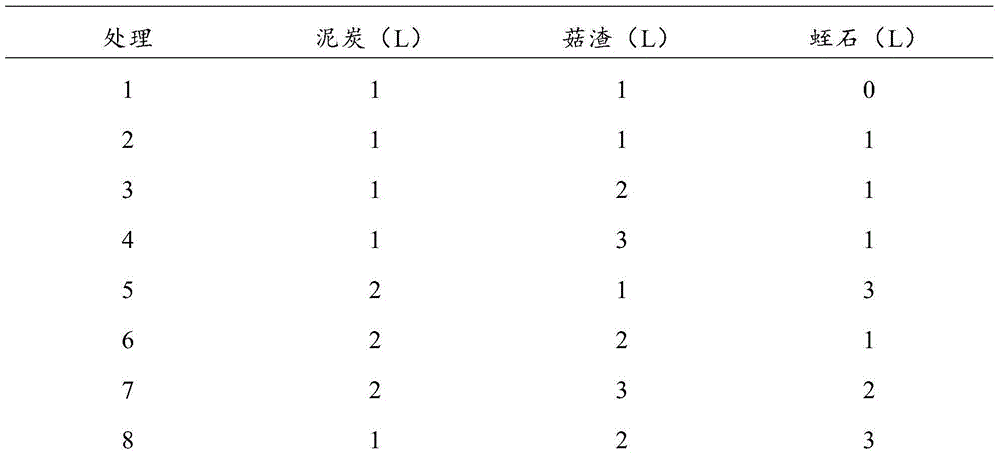Lotus root protected medium cultivation method
A cultivation method and lotus root technology, applied in the field of lotus root cultivation in protected areas, can solve the problems of lotus root planting and harvesting, time-consuming, labor-intensive, and high labor intensity, and achieve the effects of improving planting benefits, reducing labor intensity, and increasing production
- Summary
- Abstract
- Description
- Claims
- Application Information
AI Technical Summary
Problems solved by technology
Method used
Image
Examples
Embodiment 1
[0025] Embodiment 1 lotus root protected soil substrate cultivation
[0026] (1) Build greenhouses and lotus ponds
[0027] Build a steel frame greenhouse with a length of 30m and a width of 10m. There are 6 ponds in two rows in the greenhouse, with a 1-1.5m walkway between the two rows, and the area of each pond is 33.3m 2 , the pool is 50-60cm deep, 8.35m long, and 4m wide. The bottom of the pool and the cement on the four walls harden to form a hard pool.
[0028] (2) Fertilization of the whole pond
[0029] Fill the pond with a mixture of peat, mushroom dregs and vermiculite at a volume ratio of 1:3:1. The filling depth of the substrate is 25-30cm. After full fermentation, the lotus root can be planted. Every 667m 2 Apply 50kg ternary compound fertilizer (N:P:K=15:15:15) as base fertilizer.
[0030] (3) Variety selection
[0031] The tested variety is an early-maturing lotus root variety-Elian 7.
[0032] (4) Reasonable dense planting
[0033] Planting on March 8t...
Embodiment 2
[0043] Embodiment 2 lotus root protected soil substrate cultivation
[0044] (1) Build greenhouses and lotus ponds
[0045] Build a steel frame greenhouse with a length of 30m and a width of 10m. There are 6 pools in two rows, with a 1-1.5m walkway between the two rows. The area of each pool is 33.3m 2 , the pool is 50-60cm deep, 8.35m long, and 4m wide. The bottom and four walls of the pool are covered with double-layer plastic film to form a soft pool.
[0046] (2) Fertilization of the whole pond
[0047] Fill the pond with a substrate mixed with peat, mushroom residue and vermiculite at a volume ratio of 1:1:1. The depth of substrate filling is 25-30cm. After full fermentation, lotus root can be planted. Every 667m 2 Apply 50kg ternary compound fertilizer (N:P:K=15:15:15) as base fertilizer.
[0048] (3) Variety selection
[0049] The tested variety is an early-maturing lotus root variety - Pearl Buck.
[0050] (4) Reasonable dense planting
[0051] Planting on March...
Embodiment 3
[0061] Embodiment 3 lotus root protected ground matrix cultivation
[0062] (1) Build greenhouses and lotus ponds
[0063] Build a bamboo and wood greenhouse with a length of 30m and a width of 10m. There are 6 pools built in the greenhouse, with a total of 6 pools in two rows. A 1-1.5m walkway is left between the two rows. The area of each pool is 33.3m 2 , the pool is 50-60cm deep, 8.35m long, and 4m wide. The bottom of the pool and the cement on the four walls harden to form a hard pool.
[0064] (2) Fertilization of the whole pond
[0065] Fill the pond with a mixture of peat, mushroom dregs and vermiculite at a volume ratio of 2:3:3. The filling depth of the substrate is 25-30cm. After full fermentation, lotus roots can be planted. Every 667m 2 Apply 50kg ternary compound fertilizer (N:P:K=15:15:15) as base fertilizer.
[0066] (3) Variety selection
[0067] The tested variety is an early-maturing lotus root variety-Elian 7.
[0068] (4) Reasonable dense planting ...
PUM
 Login to View More
Login to View More Abstract
Description
Claims
Application Information
 Login to View More
Login to View More - R&D
- Intellectual Property
- Life Sciences
- Materials
- Tech Scout
- Unparalleled Data Quality
- Higher Quality Content
- 60% Fewer Hallucinations
Browse by: Latest US Patents, China's latest patents, Technical Efficacy Thesaurus, Application Domain, Technology Topic, Popular Technical Reports.
© 2025 PatSnap. All rights reserved.Legal|Privacy policy|Modern Slavery Act Transparency Statement|Sitemap|About US| Contact US: help@patsnap.com



